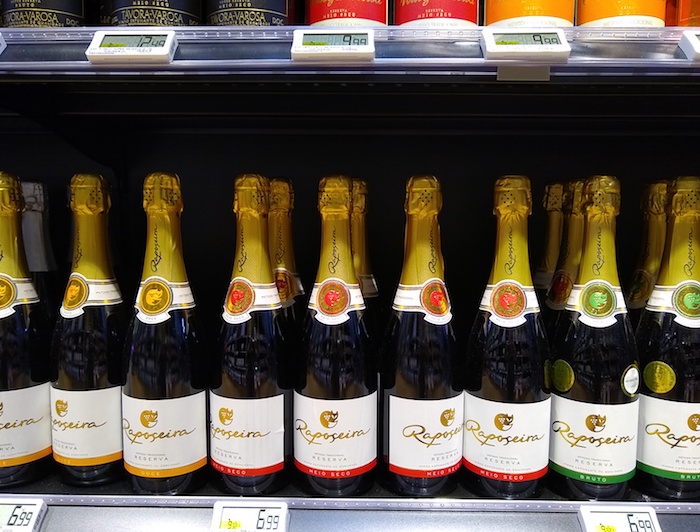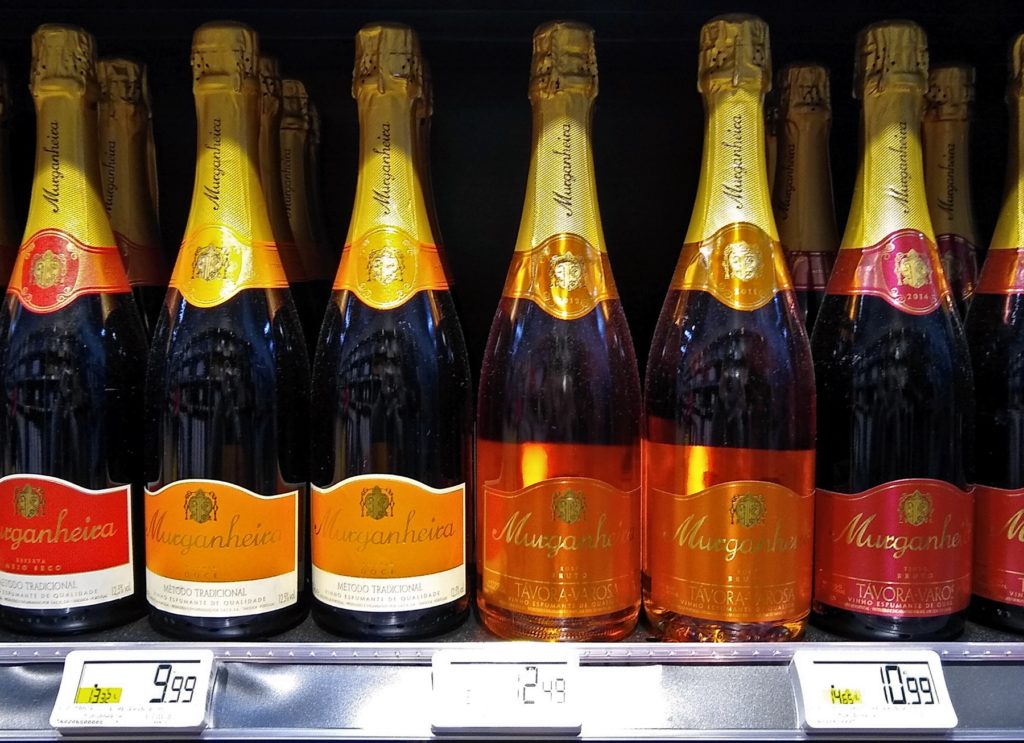Champagne, spumante, cava, prosecco, sparkling wine or bubbles. Whatever you call sparkling wine, in every country where wine is made, a sparkling variant is also made.
In Portuguese, they say ‘espumante’, which you pronounce without the first e [spoo-mán-te].
Doce or bruto?
Here the supermarkets are also filled with bubbles in December. But which one should you choose?
‘Bruto’, ‘seco’ or ‘doce’ says the label. Bruto tastes the least sweet, doce the sweetest and ‘meio seco’ is in between seco and doce. In Portugal, you don’t see many other flavour variants on the label. Or…wait a sec: Branco bruto, tinto bruto, rosé bruto?
That’s right; the Portuguese espumante is not always white but is also made in rosé and red variants. The red one is my favourite. There are also bottles of exclusive brutos, made from just one grape variety. On the label, it says, for example, ‘Touriga Nacional gross’, ‘Malvasia Fina gross’ or ‘Pinot Blanc gross’.
Wine regions of the espumantes in Portugal
Traditionally, the wine regions of Bairrada (north of Coimbra) and Távora-Varosa (east of Lamego) are known for espumantes. The latter region is not that far from us. And we have once visited a winery. The caves and wine house of Murganheira are located in the middle of nowhere, in the municipality of Tarouca near the town of Ucanha.
Visit cellars of Murganheira

When we arrive, there are already a few guests in the luxurious reception hall of Murganheira. Together we form one group. And because we are the only foreigners, we listen along with Portuguese. In contrast to the splendour of the reception areas, the atmosphere within the company is more that of a friendly family business. The young woman who shows us around is very nice and the tour even turns out to be free.
After she has given a short introduction about the brand and the history of the company, we walked into the caves. This is where the bottled espumante is kept and where the second fermentation process takes place. It’s an impressive sight, lots of corridors filled with tens of thousands of bottles. Especially where the bottles been kept for such a long time that the mould has had a chance to grow around them.

How espumante is made
As mentioned, the guide explained it to us in Portuguese, so I’ll better keep it brief. The grapes are pressed after harvest and the juice is stored in huge barrels of thousands of litres. By adding sugars and possibly yeast, the fermentation process gets started and the juice becomes alcoholic. After this fermentation, the espumante is bottled and stored in dark ‘cavas’ or caves. After this second fermentation, they remove the dead yeast from the espumante and the bottles are rebottled and a cork and a label are put on to them.

Thanks to the tour we also learn what ‘reserve’ actually means. The term ‘reserva’ on the label of wine or bubbles doesn’t mean the same thing everywhere. It varies from country to country, and even from region to region. For the espumantes from the Távora-Varosa region, the rules have been drawn up by the regional wine institute. And they relate to the duration of second fermentation in the bottles: Reserva, minimum 12 months, Extra- or Super-Reserva minimum 24 months and Velha or Grande-Reserva minimum 36 months.
Chic, but with both feet…
The tour ended at the place where the bottles were given their beautiful glossy label. Funnily enough, three women stood there stamping grapes in a small container. We watched in amazement. Surely it isn’t that those thousands of litres of grape juice… No, the guide quickly reassured us. These were colleagues who came here to mash their own grapes to make wine for their own use…

Laughing, we walked back to the chic reception hall to stock up on a few bottles. Of course, these are long gone now and were certainly not inferior to real Champagne.
Sparkling new year
That’s why we had to get ourselves some new bottles today. After some dubiousness in the aisle of the supermarket, we opted for a tinto bruto from Távora-Varosa and a branco bruto from Bairrada. No expensive or exclusive espumantes, but hopefully tasty too. That will give us a sparkling new year!
Portuguese words at the winery
| o vinho | the wine |
| branco | white |
| tinto | red |
| a vinha | the vineyard |
| a videira | the grape |
| a casta | the grape variety |
| a vindima | the grape harvest |
| sabores | flavours |
| aromas | scents |
| visita | visit |
| guia | guide |
| adega | wine house/ wine chellar |
| caves | caves |
| a marca | the brand |
| garafas | bottles |
| copo de espumante | sparkling wine glass |
| rolha | cork |
| um rótulo | a label |
| fermento | yeast |
| borra | lees |
| estourar espumante | to pop champagne |


